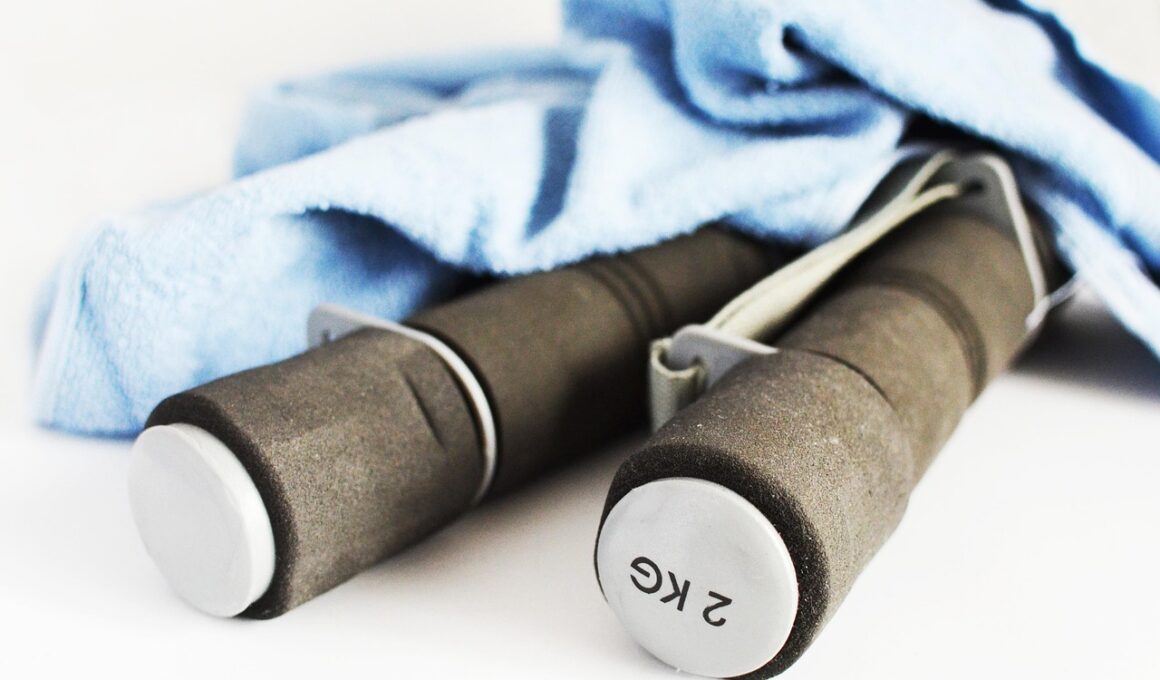Jump Rope Techniques Every Boxer Should Master
Jump rope exercises can elevate boxing fitness, promoting endurance and agility. It is vital for boxers to incorporate jump rope techniques into their training regimen. From footwork to balance improvement, the jump rope is essential in developing a boxer’s skill set. It provides numerous benefits, including enhanced coordination and cardiovascular health. Practicing various jump rope techniques helps boxers perfect their timing and rhythm. Moreover, jump ropes are portable; they can be used almost anywhere, allowing boxers to train effectively regardless of location. This simple yet challenging exercise can help boxers gain an edge over their competitors. Additionally, the mental aspect of using a jump rope is significant. It demands mental focus and concentration, key traits for any successful boxer. A well-structured jump rope routine can offer significant improvements in a boxer’s overall performance. Boxers should strive to master basic techniques before advancing to complex moves. Consistency and dedication to jump rope workouts can lead to substantial gains in speed, stamina, and agility, ultimately contributing to one’s success in the boxing ring. Embracing this powerful tool is essential for any serious boxer aiming for excellence.
The Basics of Jump Rope Techniques
To start mastering jump rope techniques, boxers should focus on the basics first. These foundational techniques prepare them for more complex moves later on. Starting with a simple two-foot jump, boxers should practice maintaining rhythm and a steady breathing pattern. Next, they can try the alternate foot jump, mimicking a jogging motion. This variation enhances foot speed and agility, which translates well into boxing movements. Another essential technique is the boxer step, allowing for light footwork while maintaining balance within the jump. Boxers also benefit from practicing the crisscross jump to improve coordination and upper body control. In addition to these, incorporating high knees while jumping can improve strength and explosiveness. As boxers grow comfortable, they should blend various techniques into their warm-ups and routines. Practicing these foundational skills ensures that jump rope workouts remain effective and engaging. Maintaining a focus on form and technique is crucial when developing proficiency. Regular training with jump ropes should be seen as an enjoyable part of boxing preparation. Boxers can record their progress and celebrate small victories, which reinforces their dedication to mastering essential jump rope techniques.
Another significant benefit of jump rope exercises is the enhancement of footwork agility. Footwork is crucial in boxing, allowing boxers to evade punches and position themselves effectively. By incorporating jump rope routines into their training, boxers can develop fast, agile footwork that increases their movement precision. Skipping rope challenges the lower body muscles, specifically the calves, quads, and hamstrings, ensuring a well-rounded workout. It also strengthens the ankles and enhances control, reducing the likelihood of injuries during fights. Boxers should focus on developing quick and light footwork, simulating actual ring movement. Alternating foot patterns while jumping mimics sidestepping and pivoting, key boxing maneuvers. Increase the intensity by incorporating speed, while maximizing the time spent on the jump rope. Practicing for intervals, like 30 seconds on and 15 seconds off, creates a high-intensity workout. This mimics fight conditions, leading to better performance. Boxers often find themselves in situations requiring rapid foot adjustments, making these drills critical. Consistent practice enables boxers to hone their reflexes, allowing them to move effortlessly. Ultimately, effective jump rope exercises will substantially benefit a boxer’s agility, allowing for improved performance in the ring.
Moreover, jump rope exercises serve as an excellent cardiovascular workout for boxers. Enhancing cardiovascular health is vital for boxers, improving their endurance during fights. Consistent jump rope workouts significantly increase heart rate while effectively burning calories. Boxers can improve their stamina, ensuring they maintain energy levels throughout all rounds of a match. Incorporating jump rope into training improves aerobic and anaerobic fitness, which directly translates to better performance in competitive scenarios. A higher fitness level allows boxers to stay active longer, reducing fatigue and maintaining defensive positioning. Jump rope workouts can promote flexibility, as the constant movement engages multiple muscle groups. Flexibility allows for more fluid movement – particularly during evasive actions. Boxers can benefit from variations like double unders or skipping backward to engage different muscle fibers and improve cardiovascular capacity. Additionally, jump ropes are easy to learn and can be adapted to suit any skill level. With various tempo changes and styles, boxers can customize their routines as they progress. The combination of fitness and fun within jumping rope can inspire higher levels of commitment to training. Regular jump rope workouts will lead to enhanced performance in the boxing ring, creating a distinct advantage during matches.
Incorporating Jump Rope into Training Regimens
Integrating jump rope exercises into a boxing training program is essential for cultivating well-rounded skills. Boxers can designate specific days to focus primarily on jump rope workouts while incorporating them into warm-ups and cooldowns as well. As skills improve, boxers can diversify their routines, engaging in interval training and specific techniques that target individual skill sets. For example, after a structured boxing workout, boxers can dedicate the last 10-15 minutes to their jump rope exercise. This practice allows boxers to practice their footwork while fatigued, mirroring actual fight scenarios. Mixing in fight-specific combinations, like skipping followed by speed bag drills, maximizes efficiency during training. Boxers can also join group training sessions focused on jump rope techniques to foster camaraderie and motivation. This supportive environment enhances skill acquisition while providing valuable feedback from peers and coaches alike. Additionally, investing in a high-quality jump rope optimized for personal use can make a tremendous difference in performance. Boxers should consider what length and weight best suits their training needs, ultimately enhancing the effectiveness of their workouts. Variety and creativity in jump rope exercises will keep training engaging and enjoyable, leading to consistent improvements and success.
Boxers also need to recognize the importance of consistency in jump rope training. Developing a consistent routine will help ensure that jump rope exercises contribute effectively toward overall skill enhancement. Establishing a specific schedule, such as jumping rope three to four times a week, helps reinforce the habit, making it an integral part of their training landscape. The key is to maintain motivation and enjoyment in the workout, preventing boredom that could hinder progress. Incorporating elements like music or additional training partners can create an enjoyable atmosphere, making each session exciting and engaging. Additionally, gradual progression in both intensity and time can lead to consistent improvement. Boxers should aim to challenge themselves with longer jump rope sessions or incorporating new techniques as they become comfortable. Tracking progress and setting achievable goals will encourage boxers to push their limits and stay dedicated to their fitness journey. Moreover, practitioners need to listen to their bodies during workouts to avoid injury and ensure a balanced approach to training. By fostering a strong connection to their workouts and evolving skill sets, boxers can capitalize on the advantages that jump rope techniques offer, enhancing their overall boxing performance.
Conclusively Enhancing Performance
In conclusion, jump rope exercises are invaluable tools for boxers dedicated to improving their overall performance and fitness. By focusing on mastering essential techniques, boxers can enhance their agility, cardiovascular capacity, and footwork. Additionally, the incorporation of jump rope routines encourages discipline and dedication, integral traits for any successful athlete. The versatility of jump rope workouts allows boxers to customize their training programs to meet personalized needs and preferences, ensuring that the workouts remain engaging and fun. As boxers progress through their training journey, monitoring progress and setting achievable milestones will motivate them to push through challenges. Regular jump rope sessions can not only improve physical fitness but also boost mental resilience, preparing boxers for the rigors of competition. It’s crucial for athletes to embrace the jump rope as a core part of their boxing fitness regime, as the results will be evident in their performance in the ring. With varying techniques, workouts can evolve over time, keeping trainers and boxers excited about their training. Ultimately, mastering jump rope techniques will position boxers to reach their full potential, setting the foundation for success in their boxing careers.
Remembering to prioritize warm-up and cooldown sessions that incorporate jump rope exercises fosters a holistic approach to boxing fitness. Creating a structured routine that includes jump rope at the beginning and end of training helps to prepare muscles for intensive workouts. Proper warm-ups can prevent injuries while also enhancing performance and readiness. Meanwhile, cooldown sessions that involve lighter jump rope techniques can aid in recovery, ensuring that muscles are not overly strained. Implementing these practices within boxing training not only builds habits but also incorporates fluidity to muscle movements. Boxers who embrace these recommendations will set themselves up for long-term progress in their training. Additionally, integrating jump rope workouts into boxing classes or training sessions allows coaches to observe participants’ movements effectively. This method also offers a chance for real-time feedback, reinforcing the benefits of jump rope routines and techniques. Classes can provide a supportive community, prioritizing accountability and motivation. By fostering camaraderie and shared objectives, boxers can cultivate a positive training atmosphere. Ultimately, prioritizing jump rope exercises will yield incredible results over time, proving to be indispensable for boxing fitness excellence.


